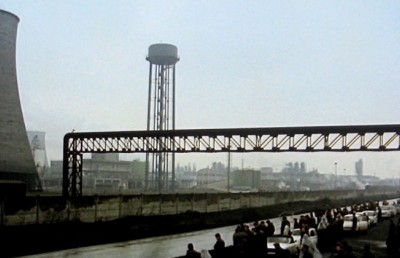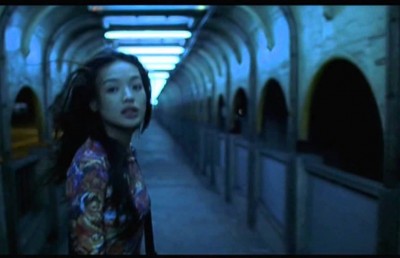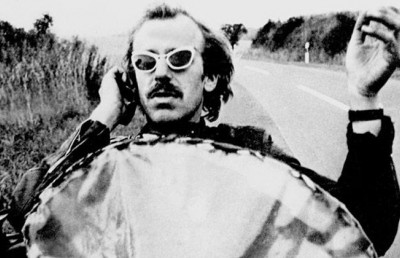The Art of Seeing Rescues the Existence of Things, part 2
Notes on the Wenders Road Films and Henri Bergson's Creative Evolution (Part 2)
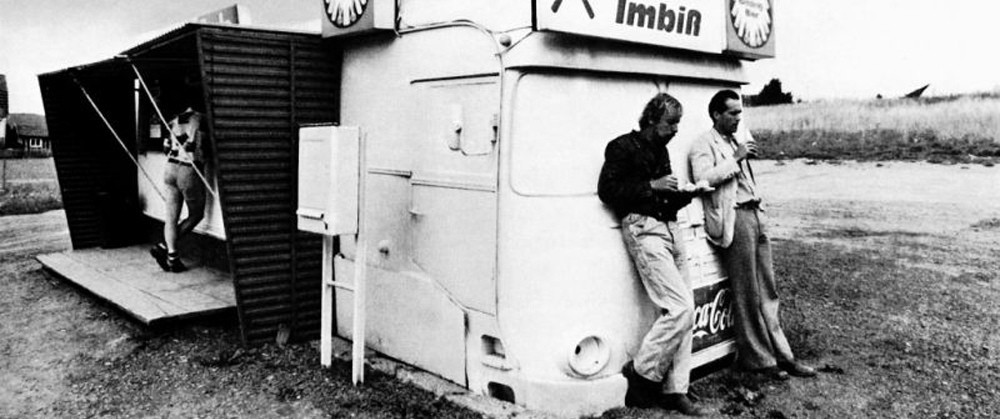
In the second part of Alice in den Städten and in Im Lauf der Zeit, the actors improvised the dialogue. Calling this material trouvailles, Wenders comments:
Pour Au fil du temps, il n’y avait pas de scénario du tout, puisque j’écrivais la nuit ce qu’on tournait le lendemain. J’ai inventé l’histoire et les situations plus que les dialogues… [36]
There was no real script for Alice in the Cities, but each night I would write whatever we were shooting the next day. I invented the story and the situations more than the actual dialogue.
In other words, he relied on the actors to give him the film’s dialogue. To an extent this would suggest a relinquishing of representation through language on Wender’s part.
In Alice in den Städten and in Im Lauf der Zeit there may be a tendency by the main character to mirror the existential perceptions of the director/author. In Alice, the incapable of writing Philip, shifts his attempt to capture the “American scene” to photography. [37] Eventually all representations through writing and photography is abandoned and instead, Philip embarks on an improvised journey around a single photograph of Alice’s grandmother’s house. Like his lead character, Wenders abandoned the written text once the production had returned to Germany:
Quand je suis venu en Europe, j’ai oublié de plus en plus le scénario. Je suis devenu de plus en plus sûr de l’histoire, contrairement aux U.S.A. où j’étais étranger. [38]
When I came to Europe, I forgot more and more the script. I became more certain of the story, in contrast to the US, where I was a stranger.
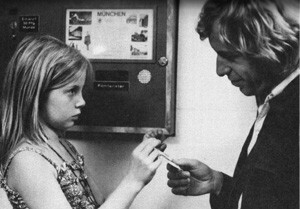
Alice in the Cities
Wenders, like Philip Winter, turned away from self-conscious intellectualized representation in the United States and gave himself over to a kind of intuitive creative flow in Germany. We see this mirrored in Philip when he abandons the intellectual project of representation in America and turns himself over to the creative movement of life. Much like when Wenders drops the written text and lets actors improvise; in the child’s company Philip evolves. The power of intuition to attain “truth” in the representative arts is a key point in Bergson’s Creative Evolution. Bergson saw intellect and intuition as representing two opposite directions of the work of consciousness. He wrote, “intuition goes in the very direction of life, intellect goes in the inverse direction.” [39]
Wenders writes about the responsibility of cinema to show things as they are and rescue the existence of things. Reinforcing this underlying idea that he is trying to get at some fundamental existence or a basic reality, Wenders calls the camera, “a weapon against the tragedy of things, against their disappearing.” [40] Vogler echoes a similar philosophical approach to his work
Un film, c’est toujours un peu l’image d’une réalité; au cinema, la realite c’est l’image que l’on se fait d’elle, comme dans un roman c’est celle qu’un écrivain s’en fait… Un acteur c’est aussi l’image d’un homme réel. [41]
A film is always a little bit the image of reality; in cinema, reality is the image we make of it, like in the novel it is what the writer makes of it….An actor is also the image of a real man
These forthright statements by Wenders and Vogler deserve our attention while they beg definitions of reality and existence. For his part, Bergson defines reality not as solid matter nor thinking mind, but living creative evolution. [42] He supposes existence to be a state of ongoing change:
We are seeking only the precise meaning that our consciousness gives to this word “exist,” and we find that for a conscious being, to exist is to change, to change is to mature, to mature is to go on creating oneself endlessly. [43]
Carr puts Bergson’s ideas on the subject this way: “To grasp reality … it is necessary to restore the movement as the cinematograph does. The movement is life.” [44] If we define reality as creative evolution however, and existence as ongoing creation; how can one represent existence and reality through words and images? This slippery problem faces not only Wenders’ protagonists but the filmmaker himself. Others have noticed this conundrum in Wenders’ work. James Franklin, for example, comments that “reality is not easily captured; ultimate truths exceed the grasp of any medium.” [45] Because of this paradoxical situation, Wenders’ films become, “musings upon media processes.” [46]
In Alice in den Städten, Philip Winter is paralysed by his writing assignment. Incapable of representing the American reality by way of the written word, he attempts to use Polaroid photography to achieve this end. As he explains to his magazine editor, “the story has to do with things that one can see … with pictures and signs.” [47] Franklin notes that Winter’s statement can be generally understood as a direct comment by Wenders to the spectator. As the narrative unfolds however, Winter’s snapshots are obviously as incapable as the written word of portraying the American reality. Winter complains that his instant snapshots, “never show what you’ve really seen.” [48] Like Wenders, Winter is powerless to capture the American scene.
Winter’s obsessive photography soon becomes a futile attempt at capturing reality. His German girlfriend in New York alludes to this when she says: “You always act as if you were the only one to experience things and that’s why you keep taking these pictures.” [49] Elsaesser comments that, “the mediations of writing, describing, recording, no longer reflect or hold the subject in any stable identity … polaroid pictures become the necessary and yet insufficient frame to hold the image of the self, which in its contact with the world is constantly threatened by dissolution.” [50] When Philip Winter complains about the complications Alice has brought into his existence, she answers him: “What else did you have to do? Just scribble in your notebook?” [51] Near the end of the film Alice asks Philip what he will do when he gets to Munich. He replies: “I’ll write an end to this story. And you?” [52] Alice simply shrugs.
Elsaesser notes that it is important in Wenders’ films to synchronize the order of writing and the order of vision as, “a way of situating the self.” [53] He also describes how, “seeing can be knowing.” [54] In Im Lauf der Zeit for example, psycho-linguist Robert and projectionist Bruno, “interact as representatives of writing and seeing respectively. (Wenders) develops the relationship in the constant intertwining and criss-crossing of these two orders of being.” [55] Cinema as a form of representation seems to hold more hope to Wenders than writing and photography does. He describes it this way:
The cinema is concerned with life … a more accurate and all-embracing documentation of our age than the theatre, music or the visual arts … Cinema can harm people by alienating them from their longings and their fears … cinema can benefit people by opening up life to them, showing them new forms of freedom. [56]
For Wenders there is a tangible connection between cinema, representation and existence:
Something happens, you see it happening, you film it as it happens, the camera sees it and records it, and you look at it again afterwards. The thing itself may no longer be there, but you can still see it, the fact of its existence hasn’t been lost. [57]
The movement has been captured for us to see. The art of seeing rescues the existence of things.
Bergson thought that the key to the representative arts lay in intuition, the power to enter by sympathy into the subject matter. Carr describes Bergson’s ideas this way:
What makes the picture is the artists vision, his entry into the very life of his subject by sympathy, something that he never succeeds in expressing perfectly, though the imperfect expression may reveal more to us than we could see without it. [58]
This is the difference between an intuitive and an intellectual approach. The artist enters the subject as opposed to, “standing over against it and watching its successive parts or selecting points of view of it.”59
In the evolution of the road films Wenders and his characters grapple with representation until in Im Lauf der Zeit Bruno and Robert seem no longer consciously preoccupied with the problem. Instead they engage in a broad movement across Germany and let the story unfold of its own accord. Vogler implies that the key lies in surrendering oneself to the medium and then letting the movement carry you along:
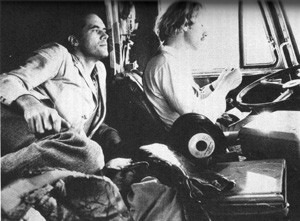
Kings of the Road
Cela a beaucoup de choses à faire avec ce que raconte Kamikase dans la cabane quand il raconte cette histoire où le garçon a appris à lire dans des lignes qu’il prend pour des voies où les lettres marchent le long des voies, et où la plume est quelque chose comme une moto.60
That has much to do with the story Kamikase recounts in the booth about the boy who learned to read in lines which he took as highways where the letters walked the length of the highway and the pen was something like an automobile.
In contrast to Alice in den Städten and Falsche Bewegung, language is a positive force in Im Lauf der Zeit, particularly when associated with children. Geist writes:
As with hearing and seeing, only a return to the values of childhood facilitates communication in Wenders’ view. Writing can block or be blocked or it can break down barriers and express something new depending on the disposition of the writer.61
Wenders describes the young boy that Bruno meets at the train station as representing, “le mieux la façon d’écrire ce qu’il voit.” [62] He echoes a similar view on the creative process of making films when he says, “story always assumes control, it knows its course … something in the subconscious knows, but you can only discover it if you let it take its course.” [63]
Bergson defined the human spirit as pure time existence, the evolution of past into present. He often quoted Plato on this subject: “God, unable to make the world eternal, gave it Time, a moving image of eternity.” [64] Carr describes it in the following terms: “It unites with matter in the act of perception, but the union can only be described in terms of time and not in terms of space. It is the memory which holds the past and unites it with the present in the living reality.” [65] Bergson saw the past as something which preserves itself automatically. He wrote, “whenever anything lives, there is open somewhere, a register in which time is being inscribed.” [66] Though we may have no distinct idea of it, the past remains present as a part of us.
What are we, in fact, what is our character, if not the condensation of the history that we have lived from our birth … Doubtless we think with only a smart part of our past, but it is with our entire past, including the original bent of our soul, that we desire, will and act. [67]
The themes of time and history continually surface throughout the road films. For example, in Alice in den Städten Philip comments, “Je suis mon histoire.” [68] The very title, Im Lauf der Zeit (In the Course of Time), was anticipated in Falsche Bewegung when Wilhelm muttered those very words in his sleep. [69] Wenders sees a connection between the creative process and his characters’ propensity to contemplate their past. He writes: “Nostalgia is belonging to the past, feeling connected with the past … every film begins as a memory or a dream, and dreams are a kind of memory … after that you’re out filming.” [70] Wenders sees conflict between past and future in his films:
Only what has actually been filmed finds a present, an equilibrium which never actually existed. I suppose my ‘security’ is there: making a film and looking at it, that’s something you can ‘hold on to’. [71]
When asked why the Rhine figures prominently in all three road movies Wenders had a ready reply. He wanted to film there to research his own past in a way similar to that undertaken by the characters in Im Lauf der Zeit. [72] Again, we see Wenders characters mirror Wenders.
Geist notes that, “only by confronting his past, Wenders believes, can a person free himself sufficiently from the trammels of the present to be able to face the future capable of change, which is to say, creatively.” [73] When Bruno returns to his childhood home he begins to understand himself better. He says: “For the first time I see myself as someone who has come through a certain time and that time is my history.” [74] The visit ends with Bruno’s refusal to sleep inside and his weeping on the back steps of the house. Corrigan writes: “Bruno, like Robert, yearns for an undefined something that has been lost, and with almost cathartic frustration of that yearning, the journey begins again.” [75] It is almost as if Bergson is discussing Bruno and Robert’s journey when he writes:
We must by a strong recoil of our personality on itself, gather up our past which is slipping away, in order to thrust it, compact and undivided, into a present it will create by entering. [76]
Ghali observes that Robert Lander, “met fin à ses hésitations et à son oscillation entre son passé et son futur. ‘Il faut tout changer’ … Cette phrase simple qui comporte l’idée de transformation insiste surtout sur l’esprit de décision qui implique une part de responsabilité.” [77] In Im Lauf der Zeit, an acknowledgement of history seems fundamental to each character’s ability to communicate with each other and ultimately to their decisions to confront the future.
Wenders structures a large section of the narrative in Alice in den Städten around Winter and Alice’s quest to find the grandmother’s house in Germany. Their search for a reality represented by a photograph turns out to be in vain when they discover that Alice’s grandmother has moved. The photograph was not able to contain the truth. In this way the story remains unresolved and Alice and winter’s movement continues again. Not simply ambiguous, Wenders road films are polysemic texts. They are about consciousness, existence, communication and mediation. They are about cinema. Wenders reminds us about the power of intuition and how seeing can be knowing. The list goes on. Perhaps what is most important, these films are about duration, the continuous progress of the past into the future. If we accept Bergson’s premise that to exist is to change and life is a great movement, then cinema is the art of seeing that great movement. And the art of seeing rescues the existence of things.
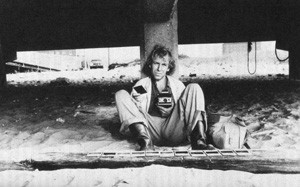
Alice in the Cities
ENDNOTES
1. Henri Bergson, Creative Evolution, trans. Arthur Mitchell, (New York: Random House, l944) 273.
2. Im Lauf der Zeit, dir. Wim Wenders, with Rudiger Vogler, Hanns Zischler, l975.
3. Timothy Corrigan, New German Film: The Displaced Image, (Austin: University of Texas Press, l983) 38.
4. H. Wildon Carr, Henri Bergson: The Philosophy of Change, (Port Washington: Kennikat Press, l9l2) 24.
5. Geist Kathe, The Cinema of Wim Wenders: From Paris, France to Paris, Texas, (Ann Arbor: U.M.I. Research Press, l988) 42.
6. Jan Dawson, Wim Wenders, trans. Carla Wartenberg, (New York: Zoetrope, l976) 2l0.
7. James Franklin, New German Cinema: From Oberhausen to Hamburg, (Boston: Twayne Publishers, l983) l60.
8. Franklin l60.
9. Ibid., l60.
10. Wim Wenders, The Logic of Images: Essays and Conversations, trans. Michael Hofmann, (London: Faber and Faber, l99l) 58.
11. Noureddine Chali, “Wim Wenders,” Cinema 76 Décembre l976: 46.
12. Carr l5.
13. Thomas Elsaesser, “Germany’s Imaginary America: Wim Wenders and Peter Handke,” European Cinema Conference Papers, ed. Susan Hayward (Modern Languages Department: Aston University, l985), 48.
14. Shelley Frisch, “The Disenchanted Image: From Goethe’s Wilhelm Meister to Wenders’ Wrong Movement,” Literature/Film Quarterly vol. 7 no. 3 (l979): 208.
15. Bergson 3.
16. Bergson 6.
17. Frisch 2ll.
18. Geist 47.
19. Geist 47.
20. Bergson l0.
21. Geist 58.
22. John Pym, rev. of Wrong Movement, by Wim Wenders, Monthly Film Bulletin, July l977: l45.
23. Pym l45.
24. Bergson l95.
25. Ibid. l95.
26. Ibid. 287.
27. Ibid. l97.
28. Geist 47.
29. Carr 58.
30. Handke/Wenders Interview 9. (Source lost.)
31. Handke/Wenders Interview 9. (Source lost.)
32. Bergson 369.
33. Wim Wenders, interview, “entretien avec Wim Wenders,” Positif l87: 27.
34. Wenders 86.
35. Wenders, interview in Positif l87 27-28.
36. Wenders, interview in Positif l87 28.
37. Alice in den Städten, dir. Wim Wenders, with Rudiger Vogler, Yella Rottlander, Filmverlag der Autoren, l974.
38. Wenders, interview in Positif l87 28.
39. Bergson 29.
40. Wenders 2.
41. Rudiger Vogler, interview, “Entretien avec Rudiger Vogler,” Cinema 76 #216 December: 54.
42. Carr l4.
43. Bergson l0.
44. Carr 28.
45. Franklin l56.
46. Franklin l56.
47. Franklin l56.
48. Franklin l57.
49. Franklin l57.
50. Elsaesser 535.
51. Alice in den Städten.
52. Alice in den Städten.
53. Elsaesser 48.
54. Elsaesser 48.
55. Elsaesser 48.
56. John Sandford, The New German Cinema, (London: Oswald Wolff, l980) ll5.
57. Wenders l-2.
58. Carr 49.
59. Carr 50.
60. Wenders, interview in Positif 187 29.
61. Geist 59.
62. Wim Wenders, “Entretien avec Wim Wenders,” Positif l98: 24.
63. Wenders 58.
64. Bergson 345
65. Carr 74.
66. Bergson 20.
67. Bergson 7.
68. Emmanuel Mairesse, rev. of Au fil du Temps, by Wim Wenders, Cahiers, Oct. l977: 62.
69. Sandford l09.
70. Wenders 37.
71. Wenders 37.
72. Geist 62.
73. Geist 6l.
74. Tarrat 3l.
75. Corrigan 29.
76. Bergson 2l8.
77. Ghali 26.
BIBLIOGRAPHY
Bergson, Henri. Creative Evolution. Trans. Arthur Mitchell. New York: Random House, l944.
Bonitzer, Pascal. “Allemagne, années errantes (Au fil du Temps),” Cahiers du Cinéma, no. 268-269, 78-80.
Carr, H. Wildon. Henri Bergson: The Philosophy of Change. New York: Kannikat Press, l970.
Corrrigan, Timothy. “The Realist Gesture in the Films of Wim Wenders: Hollywood and the New German Cinema,” Quarterly Review of Film Studies, vol. 5, no. 2 (Spring l980), 204-2l6.
Corrigan, Timothy. New German Film: The Displaced Image. Austin: University of Texas Press, l983.
Covino, Michael. “Wim Wenders: A Worldwide Homesickness,” Media Review Digest, vol. XXXI, no. 2 (Winter l977-78), 9-l9.
Elsaesser, Thomas. New German Cinema: A History. New Brunswick, NJ: Rutgers University Press, l989.
Franklin, James. New German Cinema: From Oberhausen to Hamburg. Boston: Twayne Publishers, l983.
Frenais, Jacques. “Proche de Nerval,” Cinéma 78, no. 230 (février l978), 64-66.
Frisch, Shelley. “The Disenchanted Image: From Goethe’s Wilhelm Meister to Wenders’ Wrong Movement,” Literature/Film Quarterly, vol. 7, n. 3, (l979), 208-2l4.
Geist, Kathe. The Cinema of Wim Wenders From Paris France to Paris, Texas. Ann Arbor, MI: UMI Research Press, l988.
Ghali, Noureddine. “Dossier-Auteur,” Cinéma 76, no. 2l6 (Décembre l976), 23-59.
Grant, Jacques, “Contrairement à la nature…,” Cinéma 77, no. 223 (juillet l977), 85-86.
Hayward, Susan, ed. European Cinema Conference Papers: Modern Languages Department, Aston University, l985.
Kolker, Robert Phillip and Peter Beicken. The Films of Wim Wenders: Cinema as Vision and Desire. Cambridge: Cambridge University Press, l993.
Mairesse, Emanuel. “Le cinémasse de Wim Wenders,” Cahiers du Cinéma, (Octobre l977), 6l-62.
Masson, Alain. “lignes (Alice dans les villes et faux mouvements),” Positif, l94, 58-59.
Masson, Alain and Niogret, Hubert. “Entretien avec Wim Wenders,” Positif l98, 2l-25.
Milne, Tom. Rev. of Alice in den Städten. Monthly Film Bulletin, vol. 42, no. 50l (October l975), 2l4.
Niogret, Hubert. “Entretien avec Wim Wenders,” Positif l87, 25-32.
Pym, John. “Falsche Bewegung (Wrong Movement),” Monthly Film Bulletin, vol. 44, no.522 (July l977), l45.
Sandford, John. The New German Cinema. New York: Oswald Wolfe (Publishers) Ltd., l980).
Wenders, Wim. The Logic of Images: Essays and Conversations. Trans. Michael Hofmann. London: Faber and Faber, l99l.
Wenders, Wim. “Wim Wenders: An Interview with Peter Lehman, Robin Wood & Edward Lachman,” Wide Angle, (l978) 73-79. (Date and issue unavailable. Cover removed from reference source.)
Wenders, Wim. Interview. “Wim Wenders: August l976,” Sight and Sound (Winter l977/8), 35-36.
Wenders, Wim. Emotion Pictures: Reflections on the Cinema. Trans. Shaun Whiteside in association with Michael Hofmann. London: Faber and Faber, l99l. (Art of Seeing: Part 1 )


